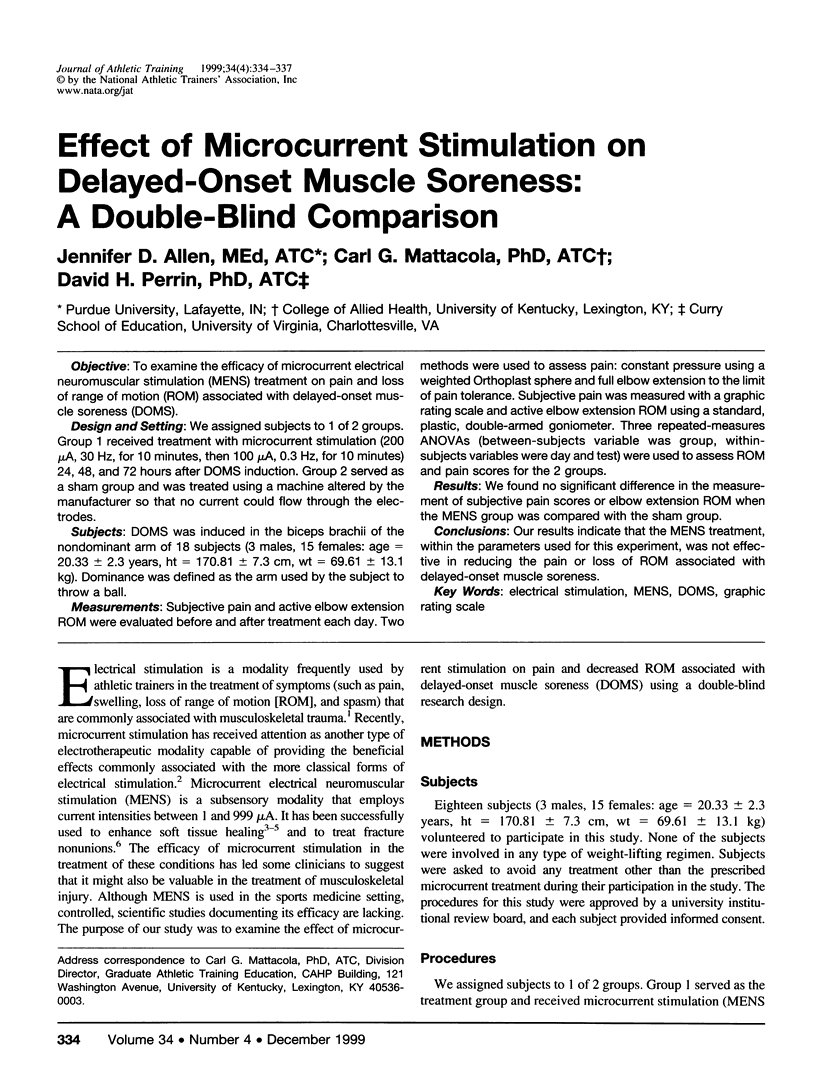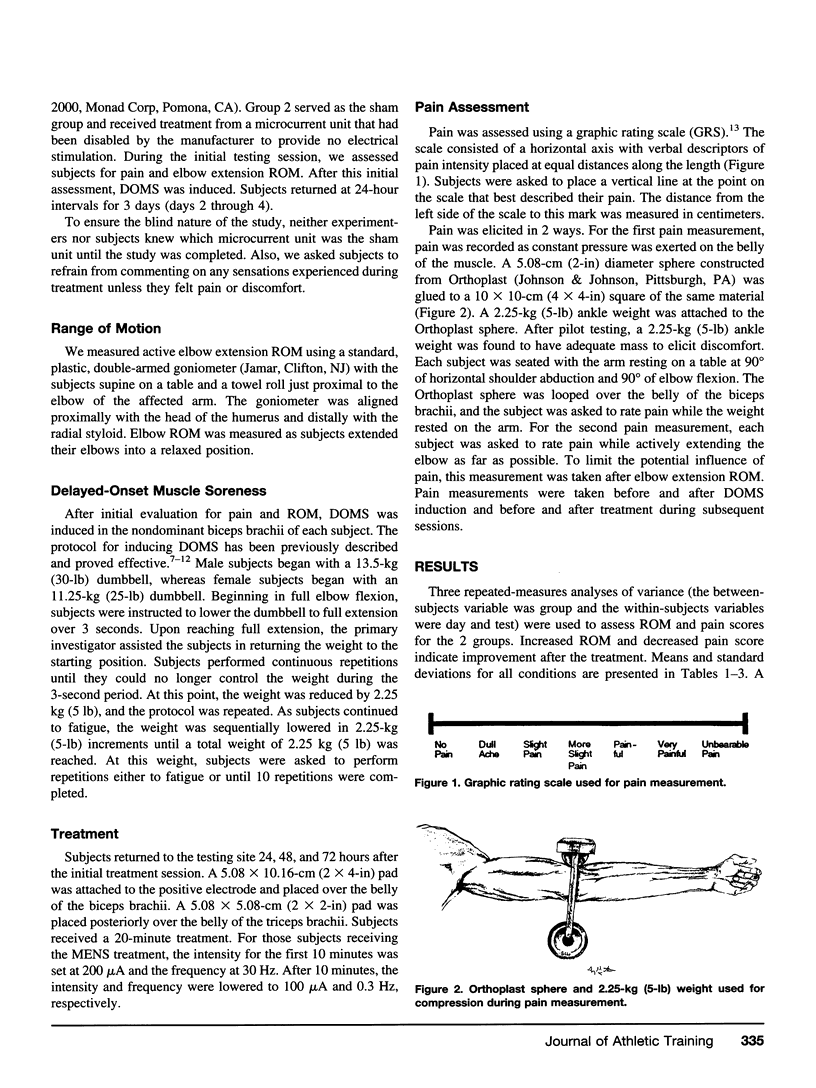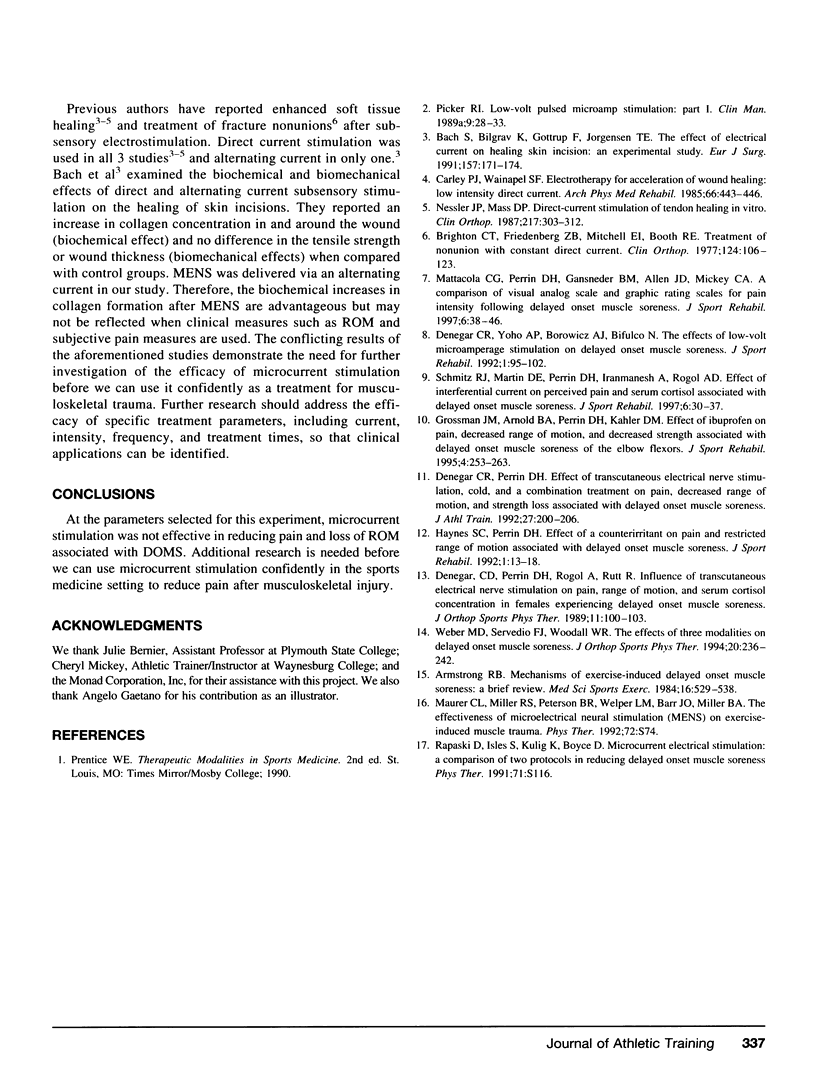Abstract
Objective:
To examine the efficacy of microcurrent electrical neuromuscular stimulation (MENS) treatment on pain and loss of range of motion (ROM) associated with delayed-onset muscle soreness (DOMS).
Design and Setting:
We assigned subjects to 1 of 2 groups. Group 1 received treatment with microcurrent stimulation (200 μA, 30 Hz, for 10 minutes, then 100 μA, 0.3 Hz, for 10 minutes) 24, 48, and 72 hours after DOMS induction. Group 2 served as a sham group and was treated using a machine altered by the manufacturer so that no current could flow through the electrodes.
Subjects:
DOMS was induced in the biceps brachii of the nondominant arm of 18 subjects (3 males, 15 females: age = 20.33 ± 2.3 years, ht = 170.81 ± 7.3 cm, wt = 69.61 ± 13.1 kg). Dominance was defined as the arm used by the subject to throw a ball.
Measurements:
Subjective pain and active elbow extension ROM were evaluated before and after treatment each day. Two methods were used to assess pain: constant pressure using a weighted Orthoplast sphere and full elbow extension to the limit of pain tolerance. Subjective pain was measured with a graphic rating scale and active elbow extension ROM using a standard, plastic, double-armed goniometer. Three repeated-measures ANOVAs (between-subjects variable was group, within- subjects variables were day and test) were used to assess ROM and pain scores for the 2 groups.
Results:
We found no significant difference in the measurement of subjective pain scores or elbow extension ROM when the MENS group was compared with the sham group.
Conclusions:
Our results indicate that the MENS treatment, within the parameters used for this experiment, was not effective in reducing the pain or loss of ROM associated with delayed-onset muscle soreness.
Keywords: electrical stimulation, MENS, DOMS, graphic rating scale
Full text
PDF



Selected References
These references are in PubMed. This may not be the complete list of references from this article.
- Armstrong R. B. Mechanisms of exercise-induced delayed onset muscular soreness: a brief review. Med Sci Sports Exerc. 1984 Dec;16(6):529–538. [PubMed] [Google Scholar]
- Bach S., Bilgrav K., Gottrup F., Jørgensen T. E. The effect of electrical current on healing skin incision. An experimental study. Eur J Surg. 1991 Mar;157(3):171–174. [PubMed] [Google Scholar]
- Brighton C. T., Friedenberg Z. B., Mitchell E. I., Booth R. E. Treatment of nonunion with constant direct current. Clin Orthop Relat Res. 1977 May;(124):106–123. [PubMed] [Google Scholar]
- Carley P. J., Wainapel S. F. Electrotherapy for acceleration of wound healing: low intensity direct current. Arch Phys Med Rehabil. 1985 Jul;66(7):443–446. [PubMed] [Google Scholar]
- Denegar C. R., Perrin D. H. Effect of transcutaneous electrical nerve stimulation, cold, and a combination treatment on pain, decreased range of motion, and strength loss associated with delayed onset muscle soreness. J Athl Train. 1992;27(3):200–206. [PMC free article] [PubMed] [Google Scholar]
- Nessler J. P., Mass D. P. Direct-current electrical stimulation of tendon healing in vitro. Clin Orthop Relat Res. 1987 Apr;(217):303–312. [PubMed] [Google Scholar]
- Weber M. D., Servedio F. J., Woodall W. R. The effects of three modalities on delayed onset muscle soreness. J Orthop Sports Phys Ther. 1994 Nov;20(5):236–242. doi: 10.2519/jospt.1994.20.5.236. [DOI] [PubMed] [Google Scholar]


